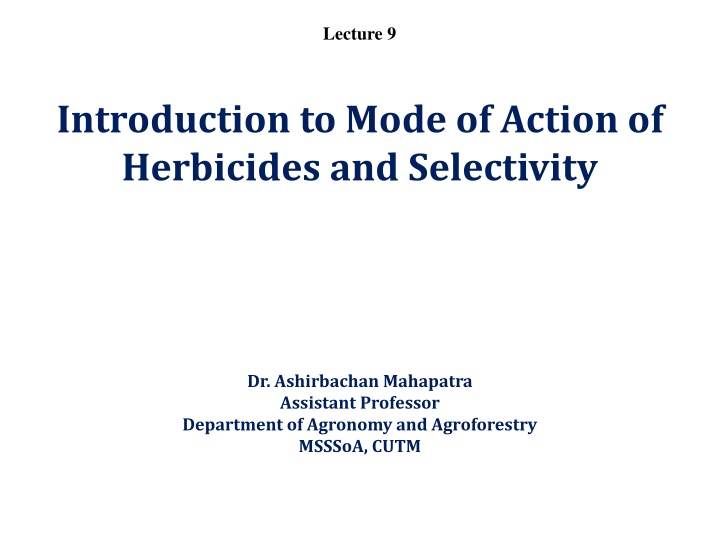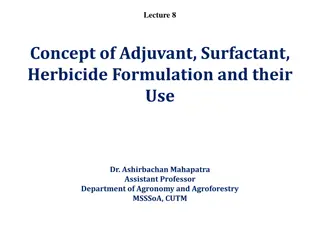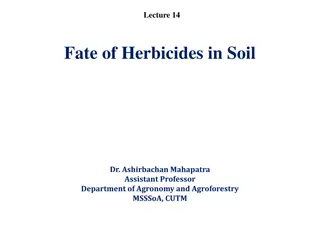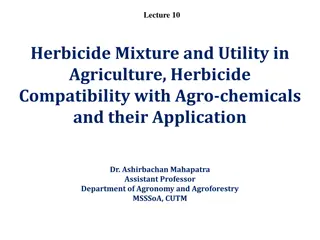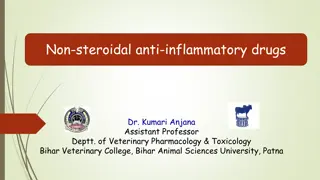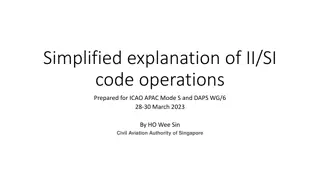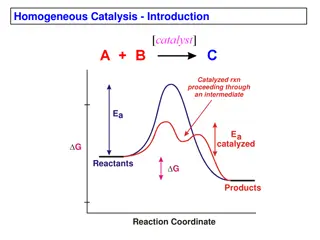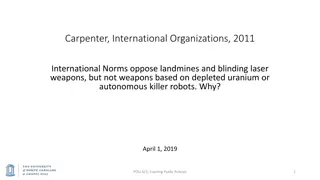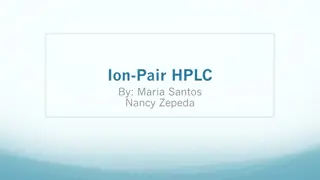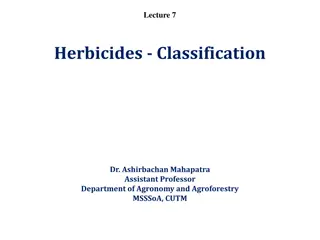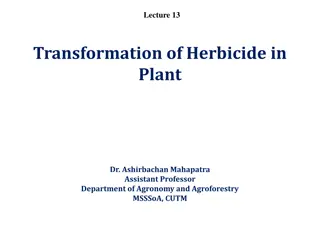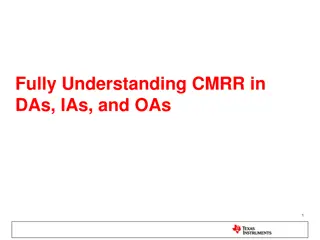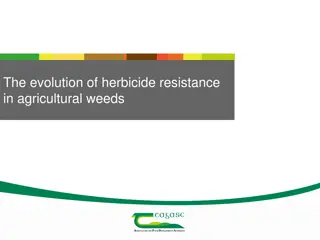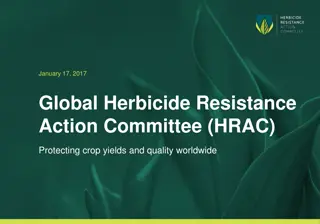Introduction to Mode of Action of Herbicides and Selectivity
Explore the fascinating world of herbicides by delving into their mode of action, from absorption to plant death. Learn how different herbicides target specific plant processes, such as disrupting cell membranes or inhibiting photosynthesis. Understand the importance of application methods and the various movements within plants that enable herbicidal effects. Discover the intricate mechanisms behind herbicidal actions and how they bring about plant death.
Download Presentation

Please find below an Image/Link to download the presentation.
The content on the website is provided AS IS for your information and personal use only. It may not be sold, licensed, or shared on other websites without obtaining consent from the author.If you encounter any issues during the download, it is possible that the publisher has removed the file from their server.
You are allowed to download the files provided on this website for personal or commercial use, subject to the condition that they are used lawfully. All files are the property of their respective owners.
The content on the website is provided AS IS for your information and personal use only. It may not be sold, licensed, or shared on other websites without obtaining consent from the author.
E N D
Presentation Transcript
Lecture 9 Introduction to Mode of Action of Herbicides and Selectivity Dr. Ashirbachan Mahapatra Assistant Professor Department of Agronomy and Agroforestry MSSSoA, CUTM
Mode of action of herbicides The term mode of action refers to the sequence of events from absorption into plants to plant death. The mode of action of the herbicide influences how the herbicide is applied. For example, contact herbicides that disrupt cell membranes, such as acifluorfen (Blazer) or paraquat (Gramoxone Extra), need to be applied postemergence to leaf tissue in order to be effective. Seedling growth inhibitors, such as trifluralin (Treflan) and alachlor (Lasso), need to be applied to the soil to effectively control newly germinated seedlings. To be effective, herbicides must 1) adequately contact plants; 2) be absorbed by plants; 3) move within the plants to the site of action, without being deactivated; and 4) reach toxic levels at the site of action. The application method used, whether preplant incorporated, preemergence, or postemergence, determines whether the herbicide will contact germinating seedlings, roots, shoots, or leaves of plants.
Node of action of herbicides refers to the entire chain/ sequences of events occurring from the first contact of the herbicides to the plant to its ultimate/final effect, which could be death of a plant. It, therefore, comprises of sum total of anatomical, physiological and biochemical responses that bring about the total phototoxic action in plants. Mechanism of action: Mechanism of action, however, refers to particular bio-chemical and physiological reactions, which bring about the ultimate herbicidal effect.
Mode of action of herbicide includes 1) Herbicide absorption/penetration/uptake 1) Foliar Application 2) Root absorption 2) Herbicide translocation in plants 1) Symplastic movement 2) Apoplastic movement 3) Mechanism of action 1) Cell division inhibition 2) Cell elongation inhibition 3) Photosynthesis inhibition 4) Respiration inhibition 5) Nucleic acid, amino acid and protein biosynthesis inhibition 6) Membrane function disruption 7) Lipid biosynthesis inhibition
Symplastic movement Herbicides move through phloem with sugars or photosynthates produces during photosynthesis and get accumulated where being used or stored. Symplastic movement is usually more applicable to post-emergence foliage active, systemic herbicides, viz. glyphosate, fenoxaprop-p-ethyl, 2,4-D etc. Apoplastic movement In apoplastic movement, the herbicides are primarily absorbed by roots and move through xylem in plants and translocated along with water or mineral nutrients atc. Apoplastic movement is usually moe applicable to pre-plant or pre-emergence soil- applied, systemic herbicides, e.g. atrazin, isoproturon, pendimethalin, fluchloralin etc.
The herbicide families listed below are grouped on the basis of how they affect plants (their mode of action) 1. Growth Regulator Herbicides (2,4-D, MCPP, dicamba, and triclopyr) Growth-regulator herbicides can act at multiple sites in a plant to disrupt hormone balance and protein synthesis and thereby cause a variety of plant growth abnormalities. These are mostly foliar applied herbicides which are systemic and translocate in both the xylem and phloem of the plant. They mimic natural plant auxins, causing abnormal growth and disruption of the conductive tissues of the plant. The injury from this family of herbicides consists of twisted, malformed leaves and stems.
2. The inhibitors of amino acid synthesis (glyphosate, halosulfuron, imazethapyr, and sulfometuron) Both foliar and soil applied herbicides are in this family. Glyphosate translocates in the phloem with photosynthate produced in the leaves. Others in this family move readily after root or foliar absorption. These herbicides inhibit certain enzymes critical to the production of amino acids. Amino acids are the building blocks of proteins. Once protein production stops, growth stops. Symptoms are stunting and symptoms associated with lack of critical proteins. The amino acid synthesis inhibitors include the following herbicide families: o Imidazolinone o Sulfonylurea o Sulfonylamino carbonyltriazolinone o Triazolopyrimidine o Amino acid-derivatives Amino acid synthesis inhibitors act on a specific enzyme to prevent the production of specific amino acids, key building blocks for normal plant growth and development.
Enzymes function as steps in biological processes. They are also extremely specialized in their function. As a result, many different enzymes are involved with the many different biological processes that occur within a plant. This herbicide-enzyme relationship is very specific and any chemical modification of the herbicide or enzyme can eliminate herbicidal activity. Acetolactate synthase (ALS ) enzyme inhibitors Imidazolinone, sulfonylurea, sulfonylamino carbonyltriazolinone and triazolopyrimidine herbicides prevent the production of three essential branched-chain amino acids by inhibiting one key plant enzyme, acetolactate synthase (ALS enzyme). These herbicides can move in the xylem and phloem to areas of new growth and taken up through plant foliage and roots. Herbicides in these families vary greatly in selectivity and may control annual and perennial broadleaf or grass weeds and may be soil or foliar applied.
EPSP synthase inhibitor The amino acid derivative herbicide inhibits the production of three essential aromatic amino acids by inhibiting another key plant enzyme, 5-enolpyruvylshikimate-3- phosphate (EPSP) synthase. In general, injury symptoms are slow to develop, especially in cold weather (seven to 14 days) and include stunting or slowing of plant growth and slow plant death. Glyphosate is an example of an amino acid derivate herbicide. It is nonselective and the site of uptake is the plant foliage. Glyphosate moves via the phloem to all parts of the plant and is an excellent perennial weed control herbicide that is active on annual weeds as well. Glyphosate is inactive in soil because of strong adsorption. Glyphosate-resistant crops with an alternative EPSP synthase enzyme have been developed through genetic engineering.
3. Cell membrane disrupters With soil activity (oxyfluorfen, lactofen, and acifluorfen). Soil and foliar applied with limited movement in soil. These herbicides enter the plant through leaves, stems, and roots, but are limited in their movement once they enter the plant. Membrane damage is due to lipid peroxidation. Symptoms are necrosis of leaves and stem. 4. Lipid biosynthesis inhibitors (diclofop, fluazifop, sethoxydim, and clethodim) Foliar applied Diclofop has both soil and foliar activity. Herbicides in this family move in both the xylem and phloem of the plant and inhibit enzymes critical in the production of lipids. Lipids are necessary to form plant membranes which are essential to growth and metabolic processes. Symptoms include stunting and death of tissue within the growing points of plants. 5. Pigment inhibitors (norflurazon, fluridone, and amitrol) Soil applied and move in the xylem except amitrol, which moves in both phloem and xylem. These herbicides inhibit carotinoid biosyntehsis, leaving chlorophyll unprotected from photooxidation. This results in foliage which lacks color. Symptoms include albino or bleached appearance of foliage.
6. Growth inhibitors of shoots (thiocarbamate herbicides including: EPTC, cycloate, pebulate, and molinate) Soil applied and somewhat volatile, requiring incorporation. Enter the plant through the roots and translocated through the xylem with the transpiration stream to the growing points in the shoot. Mode of action is unclear, but affects developing leaves in growing points of susceptible plants. Symptoms include stunting and distortion of seedling leaves. 7. Herbicides which disrupt cell division (trifluralin, DCPA, dithiopyr, oryzalin, pronamide, pendimethalin, and napropamide) All are soil applied, with limited movement in the soil. Absorbed through roots or emerging shoot tips. Once absorption takes place, movement is limited (site of action is near the site of absorption). These herbicides inhibit cell division or mitosis, except pronamide and napropamide which stop cell division before mitosis. Symptoms include stunting and swollen root tips.
8. Cell membrane disrupters No soil activity (paraquat, diquat, glufosinate, acids, oils, soaps). These herbicides are foliar applied with no soil activity. They enter the plant through the leaves and stems and do not move significantly within the plant once absorbed. These herbicides either act directly on cell membranes (acids, soaps. oils) or react with a plant process to form destructive compounds which result in membrane damage. Symptoms include rapid necrosis of the leaves and stem. 9. Inhibitors of photosynthesis (atrazine, simazine, metribuzin, cyanazine, prometryn, diuron, linuron, tebuthiuron, and bromacil) These are soil applied herbicides, however, all except simazine also have foliar activity. They move readily in the plant in the xylem with the transpiration stream where they concentrate in the leaves at the site of photosynthesis. Once there they block the electron transport system of photosynthesis, causing a build up of destructive high energy products which destroy chlorophyll and ultimately the leaf tissues. Symptoms include chlorotic (yellowed ) leaves which become necrotic.
Herbicide Injuries or Phytotoxic Symptoms Leaf injury Vein clearing Necrosis Epinasty Wilting Chlorosis Hyponasty Sunting or scorching
Selectivity of herbicides Selective herbicides have been used extensively since the introduction of 2,4-D in the late '40s. They have been one of the miracles of modem agriculture, releasing thousands of people from the drudgery of hand weeding. A selective herbicide is one that kills or retards the growth of an unwanted plant or "weed" while causing little or no injury to desirable species. 2,4-D used in turf will kill many of the broadleaf weeds that infest turf while not significantly injuring the turfgrass. But selectivity is a fickle, dynamic process. Excessive rates of 2,4-D applied to stressed turfgrass may injure the turf. Selectivity has always depended on proper herbicide application. Normally herbicides work selectively within a given rate of application. Too little herbicide and no weed control, too much and crop injury may occur. But selectivity is more complex than this. It is a dynamic process that involves the interaction of the plant, the herbicide, and the environment.
A. The Plant Factors that involve plant response include: genetic inheritance, age, growth rate, morphology, physiology, and biochemistry. Genetic Makeup: The genetic make-up of a plant determines how that plant responds to herbicides and its environment. Age: The age of the plant often determines how well an herbicide works, older plants are generally much more difficult to control than seedlings. Pre-emergence herbicides often work only on plants during the germination process and will have little effect on older plants. Growth rate: Plants which are growing rapidly are usually more susceptible to herbicides. Morphology: The morphology of a plant can help to determine its susceptibility to herbicides. Annual weeds in a deep rooted crop can be controlled because the herbicide is concentrated in the first inch of soil where the weeds and weed seeds are. Weeds with exposed growing points may be killed by contact sprays, while grasses with protected growing points may be burned back, but escape permanent injury. Certain leaf properties can allow better spray retention and thus better kill (broadleaf species vs. grasses or hairy vs. smooth leaves). Sprays tend to be retained on pigweed and mustard leaves and bounce off of onion or grass species.
Physiology: The physiology of a plant can determine how much of an herbicide will be absorbed onto the plant and the speed with which it is transported to its site of action. Plants with thick waxy cuticles or hairy leaf surfaces may not absorb sufficient herbicide to be injured. Wetting agents in herbicide formulations are used to combat these leaf characteristics and increase absorption. The transport rate of herbicides in plants varies. Usually susceptible plants transport herbicide more readily than resistant ones. Some plants can adsorb herbicides along the transport pathway, preventing them from reaching their site of action. Biochemistry: Biochemical reactions also account for selectivity. Most herbicides have a biochemical reaction within susceptible plants which accounts for their herbicidal activity. They may bind to critical enzymes within susceptible plants and block important metabolic processes (glyphosate), they may block photosynthesis (diuron) or respiration, or they may affect cell division (trifluralin). Herbicides may be absorbed as relatively innocuous chemicals (2,4-DB) and activated to deadly compounds (2,4-D) within susceptible plants. Other herbicides (atrazine) may be detoxified within some plants (com) while killing weeds which fail to metabolize the herbicide.
B. The Herbicide Herbicides are quite specific in their structures as to whether or not herbicidal activity is possible. Slight changes in conformation or structure will alter herbicidal activity. Trifluralin and benefin differ in only a methyl group moved from one side of the molecule to the other, yet trifluralin is about twice as active as benefin. Esters of phenoxy (MCPP etc.) acids are usually much more active than are amines. The manner of formulation of a herbicide can affect its selectivity. The most extreme case of this might be granular formulations which bounce off desirable plants to reach the soil where they then limit germinating weeds. Other substances known as adjuvants or surfactants are often added to improve the application properties of a liquid formulation and increase activity. The manner in which an herbicide is applied can affect its selectivity. When a broad- spectrum postemergence herbicide like glyphosate is applied as a shielded, directed, or wicked application within a susceptible crop, susceptible foliage is avoided and selectivity is achieved with this normally non-selective herbicide. Herbicides can be grouped into families based on the type of action that they have within affected plants (their mode of action).
C. The Environment There are many ways that the environment interacts with herbicide selectivity. The soil determines how much of soil applied herbicides are available for activity. Soil texture and Organic matter: Sandy soils, with low organic content, are much more active and conversely less selective than clay soils with high organic content at a given rate of herbicide application. Irrigation or rainfall: Irrigation or rainfall amount and timing influence the depth to which herbicides may move in the soil and plant growth and stress, all of which can increase or decrease herbicide selectivity. Temperature: Temperature affects the rate of herbicide transport, the rate of biochemical reactions, plant growth, plant stress, and ultimately herbicide selectivity. Wind, relative humidity, insects, plant pathogens, and nutritional status also affect plant growth and stress which can increase or decrease herbicide selectivity.
